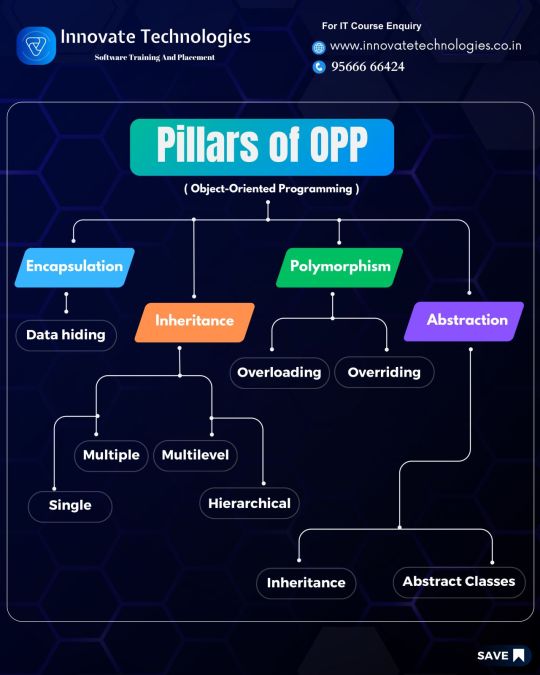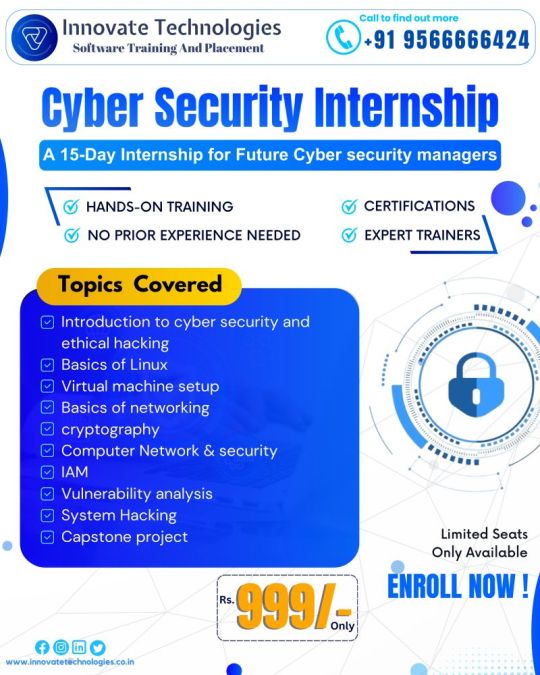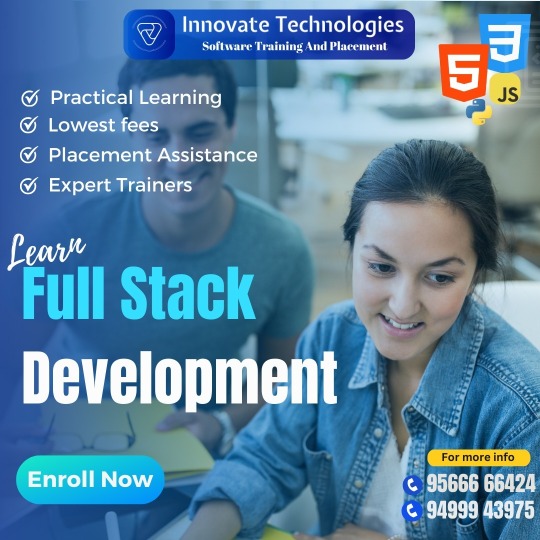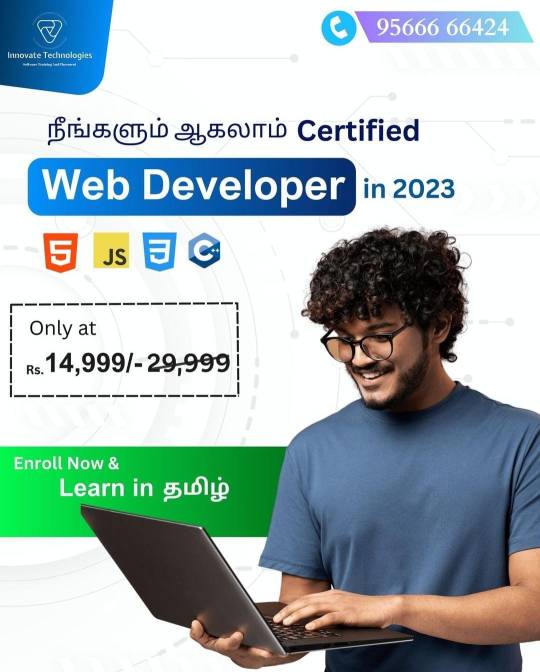Don't wanna be here? Send us removal request.
Text
Full Stack Web Development Immersive Course
Creating a Full Stack Web Development Immersive Course requires a curriculum that equips students with both breadth and depth, covering front-end, back-end, database, and deployment skills, all while reinforcing real-world project work. Here’s a breakdown of an immersive course structure, key learning modules, and approaches to help students confidently build, deploy, and manage full-stack applications.
Course Outline
Introduction to Full Stack Development
Objectives: Define what full-stack development is, the role of a full-stack developer, and an overview of the tech stack.
Topics: Overview of front-end vs. back-end, full-stack career paths, basic development workflows, and introduction to development environments.
Activities: Set up the development environment, install necessary tools (VS Code, Git, Node.js).
HTML & CSS: Building Blocks of the Web
Objectives: Cover foundational web structure with HTML and styling using CSS.
Topics: Semantic HTML5, CSS basics, layout techniques (Flexbox, Grid), and responsive design.
Activities: Build a multi-page static website, focusing on clean code and responsive layouts.
JavaScript Basics and DOM Manipulation
Objectives: Introduce JavaScript for front-end interaction and logic.
Topics: JavaScript syntax, ES6+ features, DOM manipulation, event handling.
Activities: Interactive page features like a form validator or dynamic navigation.
Front-End Frameworks: React.js
Objectives: Teach modern front-end frameworks with a focus on React.
Topics: Components, state management, props, hooks, and routing.
Activities: Build a simple SPA (Single Page Application) with dynamic routing and basic state management.
Version Control with Git & GitHub
Objectives: Understand and practice version control and collaboration techniques.
Topics: Git basics, branching, merging, conflict resolution, and GitHub for collaboration.
Activities: Pair coding project with a Git workflow; practice pull requests and code reviews.
Backend Development with Node.js & Express
Objectives: Dive into server-side development using Node.js and Express.
Topics: Introduction to servers, RESTful APIs, middleware, and handling requests/responses.
Activities: Create an API for a simple project (e.g., a to-do list) with endpoints for CRUD operations.
Database Integration: MongoDB & Mongoose
Objectives: Learn NoSQL database management and data modeling.
Topics: MongoDB basics, Mongoose ODM, CRUD operations, and data validation.
Activities: Integrate MongoDB with a Node.js application, building a database-backed API.
User Authentication and Authorization
Objectives: Implement secure user authentication and authorization.
Topics: JWT, bcrypt, role-based access control, and session management.
Activities: Add user login and registration to a project, securing routes and data.
Advanced Frontend: React State Management (Redux or Context API)
Objectives: Introduce global state management for more complex applications.
Topics: Redux basics, action creators, reducers, Context API, and hooks.
Activities: Refactor an existing React app to use Redux or Context API for state management.
APIs and Third-Party Services
Objectives: Understand API integration and data fetching.
Topics: RESTful APIs, async programming (async/await, promises), and error handling.
Activities: Integrate a third-party API (like OpenWeatherMap) into a React app.
Testing and Debugging
Objectives: Introduce front-end and back-end testing methods.
Topics: Unit testing with Jest, React Testing Library, Postman for API testing, and debugging techniques.
Activities: Write test cases for API endpoints and React components; implement debugging steps.
Deployment and CI/CD
Objectives: Teach deployment and the basics of CI/CD.
Topics: Hosting with platforms like Vercel, Netlify, or Heroku; CI/CD concepts with GitHub Actions.
Activities: Deploy a full-stack application, automate deployment through CI/CD pipelines.
Capstone Project
Objectives: Apply all learned concepts in a final, comprehensive project.
Activities: Build and deploy a full-stack application (e.g., e-commerce site, social media platform).
Deliverables: Project presentation, final code review, and demo.
Full stack course in chennai
Full stack developer course in chennai
Full stack training in chennai

0 notes
Text
Modern Full Stack Web Development Bootcamp
A Modern Full Stack Web Development Bootcamp is a comprehensive program that teaches both the front-end (client-side) and back-end (server-side) skills needed to build web applications from scratch. This type of bootcamp typically covers a wide range of technologies, frameworks, and tools commonly used in modern web development. Here's an overview of what such a bootcamp might cover:
1. Front-End Development
HTML5, CSS3, and JavaScript: Core building blocks for structuring, styling, and adding functionality to web pages.
Modern JavaScript (ES6+): Advanced features, like arrow functions, async/await, destructuring, and modules.
Frameworks/Libraries:
React: A popular JavaScript library for building interactive user interfaces.
Vue or Angular (optional): Other popular frameworks depending on the bootcamp’s focus.
CSS Frameworks and Preprocessors:
Bootstrap or Tailwind CSS: For responsive design and faster development.
Sass: A CSS preprocessor that adds features like variables and nested rules.
Version Control: Using Git and GitHub for source code management and collaboration.
2. Back-End Development
Server-Side Languages:
Node.js: Commonly used for full-stack JavaScript development.
Express: A web framework for Node.js, for handling routing, middleware, and server logic.
APIs:
RESTful APIs: Learning to build and interact with REST APIs.
GraphQL (optional): For more advanced data querying and manipulation.
Database Management:
MongoDB: A NoSQL database, often used with Node.js for its flexibility and scalability.
SQL Databases (optional): Databases like PostgreSQL or MySQL for relational data handling.
Authentication & Authorization:
Techniques for user authentication (like JSON Web Tokens) and role-based access.
3. Full Stack Projects
Real-world projects that combine front-end and back-end skills to create full-stack applications. These might include e-commerce platforms, social networks, and more.
4. DevOps and Deployment
Hosting Services: Introduction to Heroku, Netlify, or Vercel for deploying web applications.
Continuous Integration and Continuous Deployment (CI/CD): Automating tests and deployment.
Containerization: Some bootcamps introduce Docker for containerization, making it easier to deploy applications consistently.
5. Soft Skills & Career Preparation
Portfolio Development: Building a portfolio of projects to showcase to potential employers.
Interview Preparation: Practice coding challenges, whiteboarding, and soft skills.
Duration and Format
Bootcamps vary widely, but most range from 12 to 24 weeks. They’re available in both part-time and full-time formats, with options for online and in-person instruction.
A modern full-stack web development bootcamp can give you the skills to create dynamic, scalable, and high-performing web applications, making it a valuable option for breaking into tech.
Full stack course in chennai
Full stack developer course in chennai
Full stack training in chennai

0 notes
Text
Gain Multiple Skills: Full-Stack Development
Full-stack development involves mastering both front-end (client-side) and back-end (server-side) technologies. By gaining multiple skills across the full stack, you'll become versatile and adaptable, enabling you to:
Front-end Skills:
1. HTML/CSS: Structure and styling
2. JavaScript: Dynamic client-side functionality
3. React/Angular/Vue.js: Popular front-end frameworks
4. Responsive Web Design: Mobile-friendly interfaces
5. UI/UX: User experience and interface design
Back-end Skills:
1. Programming languages: Java, Python, Ruby, PHP
2. Frameworks: Node.js, Django, Ruby on Rails
3. Databases: MySQL, MongoDB, PostgreSQL
4. API Design: RESTful APIs and API security
5. Server-side rendering: Rendering dynamic content
Databases and Storage:
1. Relational databases (RDBMS)
2. NoSQL databases (MongoDB, Cassandra)
3. Cloud storage (AWS S3, Google Cloud Storage)
Soft Skills:
1. Version control (Git)
2. Agile development methodologies
3. Collaboration and team management
4. Problem-solving and debugging
5. Communication and project management
Benefits of Full-Stack Skills:
1. Increased job prospects
2. Higher salary potential
3. Flexibility in project assignments
4. Better understanding of entire application lifecycle
5. Ability to work independently or lead teams
Career Paths:
1. Full-stack developer
2. Front-end developer
3. Back-end developer
4. DevOps engineer
5. Technical lead/manager
Recommended Courses:
1. KnowledgeHut's Full-Stack Development Bootcamp
2. NxtWave's Full Stack Developer Course
3. Coursera's Full-Stack Specialization
4. edX's Full-Stack Development MicroMasters
Industry Recognition:
1. Certified Full Stack Developer (CFSD)
2. Certified Web Developer (CWD)
3. Certified Software Development Associate (CSDA)
By acquiring multiple skills across the full stack, you'll become a sought-after professional in the industry, capable of handling diverse projects and technologies.
Fullstack course in chennaiFullstack developer course in chennai
Fullstack training in chennai

0 notes
Text
Gain Multiple Skills: Full-Stack Development
Full-stack development involves mastering both front-end (client-side) and back-end (server-side) technologies. By gaining multiple skills across the full stack, you'll become versatile and adaptable, enabling you to:
Front-end Skills:
1. HTML/CSS: Structure and styling
2. JavaScript: Dynamic client-side functionality
3. React/Angular/Vue.js: Popular front-end frameworks
4. Responsive Web Design: Mobile-friendly interfaces
5. UI/UX: User experience and interface design
Back-end Skills:
1. Programming languages: Java, Python, Ruby, PHP
2. Frameworks: Node.js, Django, Ruby on Rails
3. Databases: MySQL, MongoDB, PostgreSQL
4. API Design: RESTful APIs and API security
5. Server-side rendering: Rendering dynamic content
Databases and Storage:
1. Relational databases (RDBMS)
2. NoSQL databases (MongoDB, Cassandra)
3. Cloud storage (AWS S3, Google Cloud Storage)
Soft Skills:
1. Version control (Git)
2. Agile development methodologies
3. Collaboration and team management
4. Problem-solving and debugging
5. Communication and project management
Benefits of Full-Stack Skills:
1. Increased job prospects
2. Higher salary potential
3. Flexibility in project assignments
4. Better understanding of entire application lifecycle
5. Ability to work independently or lead teams
Career Paths:
1. Full-stack developer
2. Front-end developer
3. Back-end developer
4. DevOps engineer
5. Technical lead/manager
Recommended Courses:
1. KnowledgeHut's Full-Stack Development Bootcamp
2. NxtWave's Full Stack Developer Course
3. Coursera's Full-Stack Specialization
4. edX's Full-Stack Development MicroMasters
Industry Recognition:
1. Certified Full Stack Developer (CFSD)
2. Certified Web Developer (CWD)
3. Certified Software Development Associate (CSDA)
By acquiring multiple skills across the full stack, you'll become a sought-after professional in the industry, capable of handling diverse projects and technologies.
Fullstack course in chennaiFullstack developer course in chennai
Fullstack training in chennai

0 notes
Text
software training institute in chennai
Are there programmers who write virtually bug-free code?
Writing completely bug-free code is a challenging task and is generally considered to be extremely difficult, if not impossible. Even the most experienced and skilled programmers may introduce bugs unintentionally due to the complexity of software development, the potential for unforeseen interactions, and the ever-evolving nature of software requirements.
However, some programming practices and methodologies aim to minimize the occurrence of bugs and improve overall code quality. For example:
Code Reviews: Having multiple sets of eyes review code can help catch issues that may be overlooked by the original author.
Testing: Comprehensive testing, including unit tests, integration tests, and system tests, can help identify and address bugs at different stages of development.
Static Analysis Tools: Using tools that analyze code statically can help catch potential issues before the code is even executed.
Pair Programming: Collaborative programming, where two programmers work together, can lead to better code quality as issues are identified and resolved in real-time.
Formal Methods: In some critical systems, formal methods are employed to mathematically prove the correctness of software. However, this is not practical for all types of software development.
While these practices can significantly improve code quality and reduce the likelihood of bugs, achieving absolute bug-free code remains elusive in real-world scenarios. Programmers strive to write robust, maintainable, and error-resistant code, but the dynamic and complex nature of software development makes it difficult to eliminate all potential issues.

It course in chennai
It institute in chennai
it coaching centre in chennai
best it course institute in chennai
it training institute in chennai with placement
it course institute in chennai
It courses in chennai
best it institute in chennai
top it training institute in chennai
Software training institute in chennai
1 note
·
View note
Text
it courses in chennai
How can I apply and prepare for Google Summer of Code?
Participating in Google Summer of Code (GSoC) is a great opportunity to contribute to open-source projects and gain valuable experience. Here's a step-by-step guide on how to apply and prepare for GSoC:
Research and Choose a Project: Explore the list of participating organizations on the GSoC website. Review the project ideas of different organizations. Choose a project that aligns with your skills and interests.
Learn the Basics: Familiarize yourself with the programming languages, tools, and technologies related to the chosen project.

It course in chennai
It courses in chennai
It institute in chennai
It training institute in chennai
It course institute in chennai
0 notes
Text
It training institute in chennai
What programming languages are best for cyber security?
Cybersecurity encompasses a wide range of tasks, and the best programming language for a particular aspect of cybersecurity depends on the specific task or role. Here are some programming languages commonly used in various cybersecurity domains:
Python:
Python is widely used in cybersecurity for its simplicity and readability. It has a large number of libraries and frameworks (e.g., Scapy, PyCrypto, BeautifulSoup) that are beneficial for tasks such as network scanning, penetration testing, and automation.
JavaScript:
JavaScript is essential for web security, as it's the primary language for client-side scripting. It's used in web application security testing and understanding vulnerabilities in web browsers.
C/C++:
Low-level languages like C and C++ are used in developing security tools and applications. They are common in writing exploits and analyzing malware due to their close-to-hardware capabilities. Java:
Java is often used in developing secure server-side applications. It's employed in building secure and robust enterprise-level systems.
Ruby:
Ruby is used in web application security testing, and the Metasploit Framework, a popular penetration testing tool, is written in Ruby.
Go (Golang):
Go is known for its efficiency and is used in developing scalable and high-performance security tools. Tools like Docker and Kubernetes, which are significant in the DevSecOps space, are written in Go.
SQL:
SQL is crucial for database security. Knowledge of SQL is essential for protecting databases and conducting security assessments. Bash/Shell scripting:
Scripting languages like Bash are essential for writing automation scripts and managing system configurations securely. Remember that the choice of programming language depends on the specific task or project within the cybersecurity domain. Many cybersecurity professionals use a combination of these languages depending on the requirements of the job at hand. Additionally, staying updated with the latest trends and technologies in the cybersecurity field is crucial for effective defense and mitigation strategies.

IT COURSE IN CHENNAI
IT TRAINING INSTITUTE IN CHENNAI
IT TRAINNG INSTITUTE IN CHENNAI
IT INSTITUTE IN CHENNAI
1 note
·
View note
Text
full stack development course in chennai
For a full-stack developer, what languages are required?
A full-stack developer is responsible for both the front-end and back-end development of a web application, as well as potentially working with databases and other infrastructure components. The specific languages and technologies can vary depending on the requirements of the project, but here's a general overview:
full stack developer course in chennai
full stack training in chennai
full stack development course in chennai

0 notes
Text
full stack development in chennai
What are the skills needed for a Java full stack developer?
A Java full stack developer is responsible for working on both the front-end and back-end aspects of web development using Java technologies. Here is a list of skills that are typically required for a Java full stack developer: Java Programming:Proficiency in Java programming language, including knowledge of core concepts like object-oriented programming (OOP) and design patterns. Spring Framework:Experience with the Spring Framework, which is widely used for building Java-based enterprise applications.Knowledge of Spring Boot for developing microservices. Web Development:Proficiency in HTML, CSS, and JavaScript for front-end development.Familiarity with front-end frameworks and libraries such as Angular, React, or Vue.js. Database Management:Skills in working with relational databases like MySQL, PostgreSQL, or Oracle.Knowledge of database design and ORM (Object-Relational Mapping) frameworks like Hibernate. RESTful Web Services:Understanding and experience in building RESTful APIs using frameworks like Spring MVC. Version Control:Proficiency with version control systems, such as Git, for source code management. Build Tools:Experience with build tools like Maven or Gradle for managing project dependencies and building applications. Backend Development:Competence in server-side development using Java-based technologies.Understanding of server-side frameworks like Spring MVC, Spring Boot, or Java EE. Web Application Servers:Knowledge of deploying applications on web servers such as Apache Tomcat or Jetty. Testing:Familiarity with unit testing frameworks like JUnit.Knowledge of testing tools and methodologies for both front-end and back-end. Security Best Practices:Awareness of security best practices and the ability to implement secure coding techniques. DevOps and Deployment:Understanding of deployment processes and tools.Familiarity with containerization technologies like Docker. Agile Methodologies:Experience working in an Agile development environment and understanding of Agile methodologies. Problem-Solving Skills:Strong analytical and problem-solving skills to troubleshoot and debug issues in both front-end and back-end components. Soft Skills:Good communication skills and the ability to work collaboratively in a team.Adaptability and willingness to learn and stay updated on industry trends. Keep in mind that the specific requirements for a Java full stack developer may vary depending on the job role, the company's technology stack, and project requirements. As technologies evolve, it's also essential for developers to stay updated and continuously improve their skills.

full stack developer course in chennai full stack training in chennai full stack development course in chennai
0 notes
Text
it training institute in chennai
Where can I get Empower software training?
As of my last knowledge update in January 2022, I don't have specific information about a software called "Empower" or any associated training programs. It's possible that new software or training options have emerged since then.
If "Empower" is a specific software related to a particular industry or field, I recommend checking the official website of the software or contacting the company directly. They often provide information about training resources, documentation, and support.
Additionally, you can search for online training platforms, educational websites, or training institutes that offer courses on the specific software. Popular platforms like Udemy, Coursera, LinkedIn Learning, and others often have courses on various software applications.
If "Empower" is related to a specific industry, you might want to check with industry associations, conferences, or events, as they sometimes offer training sessions or workshops for related software.
Remember to verify the relevance and legitimacy of the training options you find to ensure they meet your specific needs.
It course in chennai
It training institute in chennai
Best it training in chennai

0 notes
Text

How do I learn full stack web development online? Learning full-stack web development online can be a rewarding journey, and there are many resources available to help you acquire the necessary skills. Here's a step-by-step guide to help you get started: Set Clear Goals: Define what you want to achieve with full-stack development. Identify the technologies you want to learn (front-end, back-end, databases). Learn the Basics: Start with HTML, CSS, and JavaScript for front-end development. Understand the Document Object Model (DOM) and basic web page structure. Front-End Development: Learn a front-end framework/library like React, Angular, or Vue.js. Understand responsive design and mobile-first development. Back-End Development: Choose a back-end language such as Node.js (JavaScript), Python (Django or Flask), Ruby (Ruby on Rails), Java (Spring Boot), or PHP. Learn about server-side development, handling HTTP requests, and building APIs. Databases: Understand basic database concepts and learn SQL. Explore both relational (e.g., MySQL, PostgreSQL) and NoSQL databases (e.g., MongoDB). Version Control: Learn Git and GitHub for version control. Understand branching and merging. APIs (Application Programming Interfaces): Learn how to consume and create APIs. Understand RESTful principles. Server Deployment: Familiarize yourself with server deployment and hosting platforms like Heroku, AWS, or DigitalOcean. Testing: Learn about testing frameworks for both front-end and back-end code. Understand unit testing, integration testing, and end-to-end testing. Build Tools and Package Managers: Get comfortable with build tools like Webpack and task runners like Gulp. Learn about package managers like npm or yarn. Learn a Backend Framework: Master a backend framework that aligns with the language you've chosen (e.g., Express for Node.js, Django for Python, Ruby on Rails for Ruby). Security and Authentication: Understand web security best practices. Learn about user authentication and authorization. Continuous Integration/Continuous Deployment (CI/CD): Explore CI/CD tools to automate the testing and deployment process. Stay Updated: Follow industry blogs, forums, and social media to stay informed about the latest developments. Build Projects: Apply your knowledge by working on real projects. This helps reinforce your skills and build a portfolio. Join a Community: Participate in online forums, communities, or coding meetups to connect with other learners and professionals. Practice, Practice, Practice: Regularly practice coding and problem-solving. Use platforms like HackerRank, LeetCode, or CodeSignal. Portfolio: Create a portfolio showcasing your projects and skills. This is crucial when applying for jobs. Explore Advanced Topics: Depending on your interests, delve into advanced topics such as microservices, containerization (Docker), and serverless architecture. Consider Formal Education: If you prefer a structured learning path, consider enrolling in online courses, bootcamps, or pursuing a degree in computer science. Remember that learning web development is an ongoing process, and staying curious and adaptable is key. As technology evolves, keep updating your skills accordingly.
full stack developer course in chennai
full stack training in chennai
full stack development course in chennai
0 notes
Text
it course in chennai
Where can I get the source code for Android apps?
The source code for Android apps is typically available in the form of open-source projects hosted on platforms like GitHub, GitLab, or Bitbucket. Here are some common steps to find Android app source code:
GitHub: GitHub is a popular platform for hosting and sharing code. You can search for Android projects using the GitHub search bar. For example, if you're interested in a specific app, you can search for its name followed by "GitHub" to find its repository.
GitLab: Similar to GitHub, GitLab is another platform that hosts code repositories. You can search for Android projects on GitLab using their search feature.
Bitbucket: Bitbucket is another platform where developers host their code repositories. You can use the search function on Bitbucket to find Android projects.
Google: Sometimes, developers may share their code on their personal blogs or websites. You can use a search engine like Google and search for the app's name followed by "GitHub" or "source code" to find relevant repositories.
XDA Developers: XDA Developers is a forum where Android developers often share their work. You might find links to source code or discussions about the development process there.
Remember that not all Android apps have open-source code available. Many developers keep their code private for various reasons, such as proprietary information, business interests, or licensing considerations. Always respect the licenses and terms provided by the developers when using or contributing to their code.

it course in chennai
it institute in chennai
it training institute in chennai
best it training institute in chennai
it coaching centre in chennai
best it course institute in chennai
0 notes
Text

it course in chennai
Is it good to learn JavaScript?
Yes, learning JavaScript can be highly beneficial for several reasons:
Versatility: JavaScript is a versatile programming language that can be used for both front-end and back-end development. It is an essential part of web development and is widely supported by browsers, making it a crucial language for creating interactive and dynamic websites.
Popularity: JavaScript is one of the most popular programming languages in the world. Many large tech companies use it, and it has a vast and active community of developers. Learning a popular language can open up more opportunities for collaboration, resources, and support.
Full Stack Development: If you aspire to become a full-stack developer, knowing JavaScript is essential. With the advent of technologies like Node.js, JavaScript can now be used on the server-side as well, enabling you to work on both the front end and back end of web applications.
Job Opportunities: There is a high demand for JavaScript developers in the job market. Many companies look for developers who are proficient in JavaScript, especially for roles related to web development.
Ecosystem and Frameworks: JavaScript has a rich ecosystem of libraries and frameworks that can significantly speed up development. Popular front-end frameworks like React, Angular, and Vue.js are all based on JavaScript. On the back end, Node.js is a popular choice for server-side development.
Cross-platform Development: JavaScript can also be used for mobile app development. With frameworks like React Native and frameworks like Apache Cordova, developers can build cross-platform mobile applications using their existing JavaScript skills.
Community Support: JavaScript has a large and active community of developers. This means there are abundant resources, tutorials, and forums available for learning and problem-solving. This community support can be invaluable when you are learning and working with the language.
In summary, learning JavaScript can be a valuable investment in your programming skills, providing you with the ability to create dynamic and interactive web applications and opening up various opportunities in the job market.
it course in chennai
it institute in chennai
it training institute in chennai
best it training institute in chennai
it coaching centre in chennai
best it course institute in chennai
it training institute in chennai with placement
it course institute in chennai
it training and placement in chennai
it courses with job placement in chennai
best it institute in chennai
top it training institute in chennai
1 note
·
View note